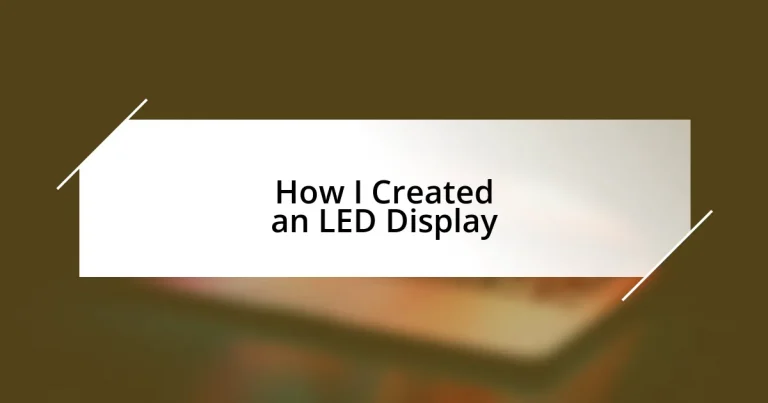Key takeaways:
- LED displays combine technology and artistry, using light-emitting diodes for bright, energy-efficient visuals.
- The key components of an LED display include LED modules, controllers, power supplies, housing, and data transmission cables.
- Design layout is crucial for visual impact, considering factors like arrangement, viewing distance, and modularity for future upgrades.
- Power supply selection and coding/debugging are critical for the display’s performance and functionality, highlighting the importance of careful planning and perseverance.

Understanding LED Display Basics
LED displays are fascinating because they bring together technology and artistry in a way that’s easy to appreciate. Each pixel in an LED display is made of tiny light-emitting diodes that can illuminate in various colors, giving us the vivid images we see. I remember the first time I attended an outdoor concert, and the massive LED screen showcased stunning visuals that synchronized perfectly with the music; it was mesmerizing!
When we think about the basics, it’s essential to understand that LED displays work by modulating light through these diodes, allowing for brilliant colors and contrast. Have you ever noticed how the outdoor ads seem to shine even during the day? That’s due to the brightness and clarity that LEDs provide, which is something I’ve always admired in technology. It makes me wonder how far we’ve come from the early days of traditional billboards.
A significant aspect of LED displays is their energy efficiency. They consume less power compared to traditional lighting, which means they are not just cost-effective for businesses but also better for the environment. I recall a project where we replaced an outdated billboard with an LED one, and the reduction in energy costs was incredible—almost like a breath of fresh air. It’s exciting to see how something so small can have such a big impact!
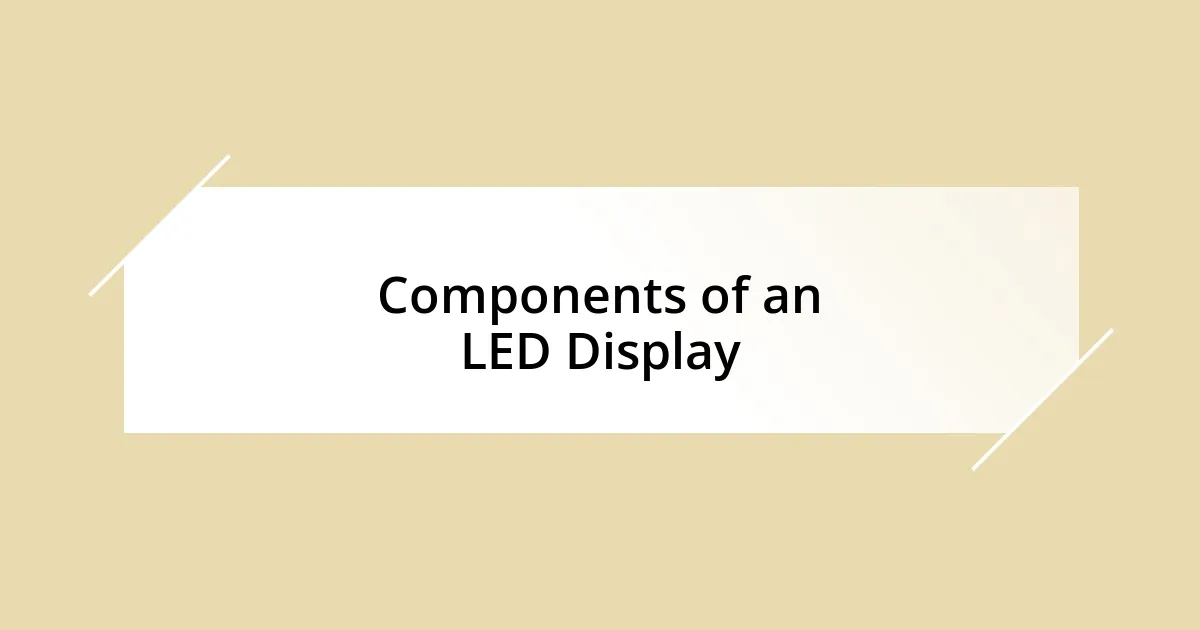
Components of an LED Display
The components of an LED display are essential for its functionality and performance. Each part plays a crucial role in ensuring that the display functions properly and effectively. When I was working on my first LED project, I was amazed by how these elements came together to create the final product.
Here are the key components you’ll find in an LED display:
- LED Modules: These are clusters of LEDs that combine to form a pixel. They’re responsible for the color and brightness of the display.
- Controller: This brain of the display interprets the signals and manages how the LEDs light up. I found it fascinating to see how this component determines the overall visual output.
- Power Supply: It provides the necessary energy for the display to operate and maintains consistent brightness.
- Housing: The outer structure protects the sensitive components from environmental elements, ensuring durability. I remember building a housing that not only enhanced the aesthetics but also fortified it against the rain during a music festival.
- Data Transmission Cables: These cables facilitate communication between the controller and the LED modules, making smooth video playback possible.
Understanding these components deepened my appreciation for LED technology. Each piece works in harmony to produce stunning visuals that draw people in.
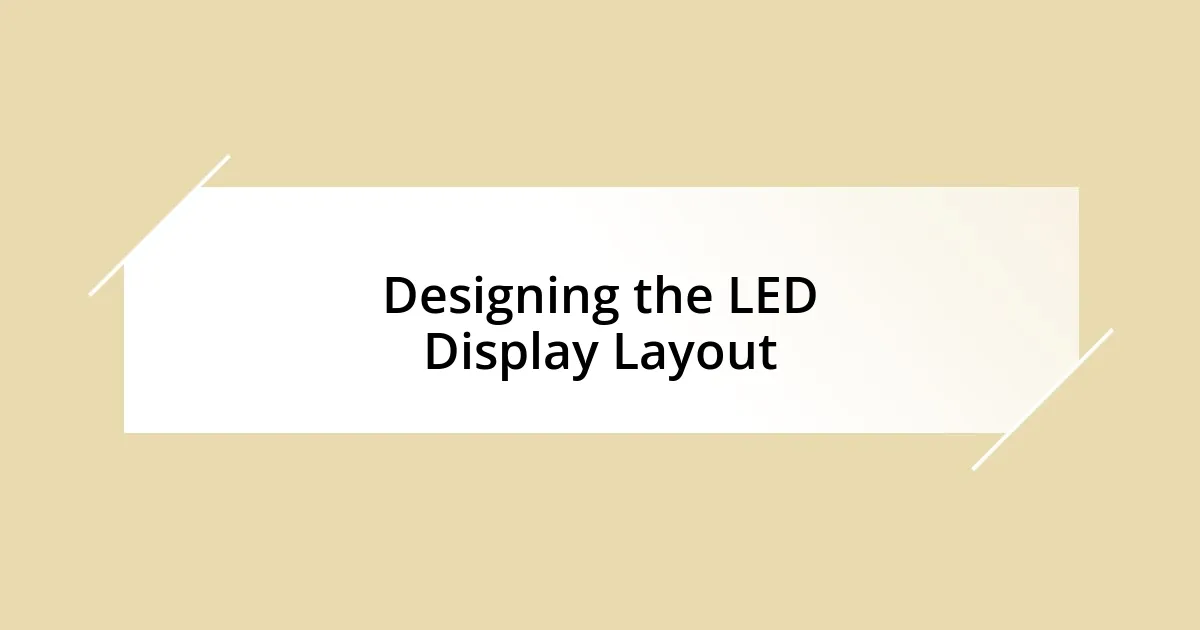
Designing the LED Display Layout
Designing an LED display layout is as much an artistic endeavor as it is a technical one. When I embarked on my first design project, I was struck by how the arrangement of the modules could influence the overall visual impact. For instance, I played with varying pixel densities to achieve a balance between detail and brightness. It’s fascinating how the layout can turn a simple message into an engaging experience, and I found that experimenting with shapes and sizes added an element of creativity that simply made it more enjoyable.
Another key consideration in layout design is viewing distance. I remember receiving feedback from a group after installing an LED display. They pointed out how important it was to consider how far away people would be from the screen. This awareness led me to design with clarity in mind, ensuring that text and images were easily readable even from a distance. Larger displays, especially placed outdoors, benefit from larger pixels for visibility, while indoor displays can afford a tighter pixel pitch for high resolution.
Lastly, I always emphasize the importance of modularity in my designs. Modular layouts allow for easy upgrades or repairs, which I learned the hard way after a storm caused some damage to one of my earlier displays. By creating a design that could be easily modified or expanded, I not only saved time but also ensured the display remained state-of-the-art. A flexible approach keeps the design robust and adaptable for future needs, which is something I now prioritize in every project.
| Design Aspect | Details |
|---|---|
| Arrangement | Creative layouts influence visual impact. Consider varying pixel densities. |
| Viewing Distance | Optimize text and image sizes for readability based on audience distance. |
| Modularity | Design for easy upgrades or repairs to future-proof the display. |

Choosing the Right Power Supply
Choosing the right power supply for your LED display can make all the difference in how well it performs. I still remember the first time I underestimated the importance of a quality power supply. After finishing my DIY display, I faced intermittent flickering, and it turned out my power source was underpowered. It’s crucial to select a power supply that not only matches the voltage requirements but also offers sufficient current to prevent those frustrating issues.
It’s not just about the numbers, though. When I was working on a particularly ambitious project, I spent hours researching various power supplies. I leaned towards ones with built-in overcurrent protection because I wanted to ensure stability and safety. Connecting everything and knowing I had a robust power supply gave me peace of mind. Have you ever felt that weight lifted when you realize you’ve made the right choice for your project?
Lastly, always consider efficiency ratings. I once opted for a less expensive option to cut costs, only to find that it drained more energy than anticipated. This not only affected my project’s performance, but it also slapped me with higher electricity bills. Trust me, investing in a highly efficient power supply can save you a lot of headaches—and money—in the long run. So take your time in selecting the right one; your LED display will thank you!
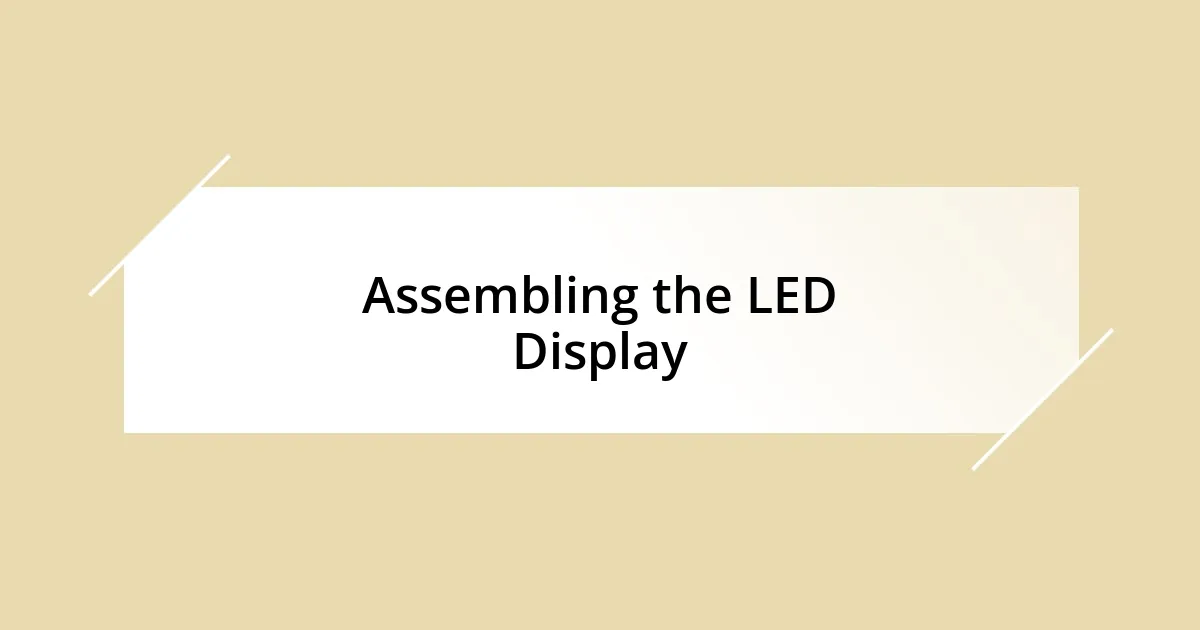
Assembling the LED Display
Assembling the LED display is where the excitement truly begins. When I took my first kit out of the box, I felt a mix of anticipation and nervousness. Aligning those tiny modules neatly was a satisfying puzzle. I discovered that securing them with even pressure made a huge difference; it ensured uniform brightness across the display. Have you ever experienced that moment of clarity when everything falls into place? That’s precisely how I felt as I fastened my first module.
Next, I recommend paying close attention to the wiring. Good connections can be the difference between smooth operation and chaotic flickering that keeps you up at night. I learned this lesson the hard way during a late-night assembly session. I inadvertently misaligned a few wires and ended up with a colorful mess instead of my intended image. Taking my time to double-check every connection, I now firmly advocate for methodical wiring as a best practice.
Lastly, don’t overlook the importance of testing as you assemble. I remember the thrill of powering on the display for the first time; it was a blend of dread and excitement. That moment of truth can really make your heart race! I make it a habit to run tests after connecting each component to spot any issues early on. This proactive approach not only saves time but also boosts your confidence in your final product. Who doesn’t want that feeling of accomplishment when you see your hard work illuminate before your eyes?
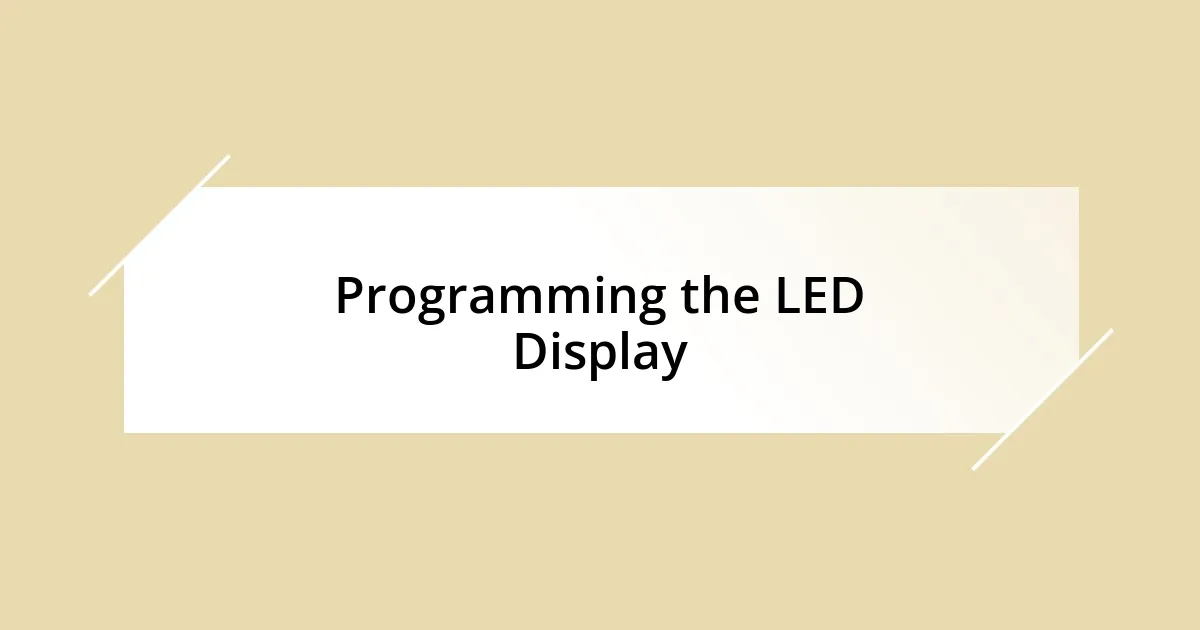
Programming the LED Display
When it comes to programming the LED display, I like to think of it as giving life to my creation. The first time I dove into coding for my display, I was overwhelmed yet exhilarated. I used Arduino for the project, and I vividly remember the mix of excitement and frustration as I sifted through code trying to make each pixel display a specific color. Have you ever felt that rush when everything finally clicks? I did when I got my first “Hello, World!” message shining brightly across the screen.
Debugging is a crucial aspect of programming that often gets swept under the rug. There was a point during my project when the display showed bizarre colors that made no sense at all. After some investigation, I realized I had a syntax error in my code. I can’t stress enough how important it is to take breaks and return with fresh eyes—sometimes stepping away can help you see the problem more clearly. It’s a reminder that perseverance pays off, especially when you are so close to achieving your vision.
I’ve found that experimenting with different libraries can open up a world of possibilities for your display’s capabilities. During one of my projects, I tried a library that allowed for smoother animations and transitions. The moment I saw the vibrant colors flowing seamlessly across the display, I thought, “Wow, I didn’t know it could look this good!” Have you ever stumbled upon a feature that completely transformed your project? It made me appreciate how programming isn’t just about functionality; it’s about unleashing creativity and elevating your display to something truly impressive.

Troubleshooting Common Issues
When troubleshooting common issues with an LED display, the first thing I always check is the power supply. I recall a moment early in my project when my display refused to turn on altogether. After some panic and a bit of head-scratching, I discovered that the power adapter wasn’t providing sufficient voltage. Have you ever felt the sinking feeling of despair only to find a simple solution right under your nose? It’s a good reminder that the simplest things can have the biggest impact.
Another common issue I’ve encountered is pixel malfunctions. During my first few tests, one corner of the display refused to light up, leaving me baffled. I decided to take a systematic approach, testing each module individually, and found that a single connector was loose. I felt a rush of relief, thinking about how close I’d been to giving up. Have you ever experienced that mix of frustration and joy in troubleshooting? It’s moments like these that teach us the value of patience and persistence.
Last but not least, keep an eye out for software glitches that can lead to unexpected behavior. There was a time when my display would reset randomly, throwing my careful programming into disarray. I went through my code line by line, and eventually figured out that it was a memory leak issue. This experience really opened my eyes to the importance of optimizing my code and using resources wisely. Have you ever had a moment where a setback pushed you to improve? It’s a journey of growth, turning frustrating moments into an avenue for learning and better results in your projects.












